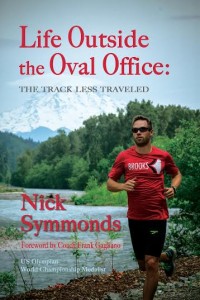Book Review: Life Outside The Oval Office, By Nick Symmonds
By Jonathan Gault
October 2014
Nick Symmonds has accomplished a lot on the track: five straight USATF 800 championships from 2008 to 2012, a 1:42.95 800 pb (#3 all-time among Americans) and a silver medal at the 2013 World Championships. He’s also been known to enjoy the spotlight, earning a reputation as one of the best interviews on the circuit and making headlines for asking Paris Hilton out on a date and setting the American record in the beer mile in 2012. So it’s no surprise that Symmonds, always eager to speak his mind, decided to write a book, Life Outside the Oval Office: The Track Less Traveled (available October 21).
As the title suggests, this is not a training manifesto. You won’t find the secrets to Symmonds’ success or the key workouts he ran before taking fifth at the 2012 Olympics and second at the 2013 Worlds (if you want that, Symmonds sold his training log last year). While aspects of the book will appeal to hard-core running fans, it’s clear that the title is intended for a wider audience — Symmonds takes the time to explain concepts such as the USATF Championships, qualifying standards and appearance fees.
The first few chapters, like most autobiographies, detail Symmonds’ early life, from his childhood in Boise to his college years at D-III Willamette University in Salem, Ore. The most interesting stuff comes later, once Symmonds begins his pro career in 2006, but the book moves along at a good pace and the reader is never bored. Part of that is due to the fact that Symmonds has an interesting story to tell. He details how he struggled with synovial plica syndrome as a sophomore at Willamette and joined a fraternity. His frustration with his injury and his new coach caused running to fall off his list of priorities until his friend and mentor, Sam Lapray, intervened and got his career back on track. But Symmonds also deserves credit as an author. Symmonds doesn’t dawdle and long stories are reserved only for pivotal moments in his life, such as winning the 2008 Olympic Trials. That makes the book easy to follow and keeps the reader interested.
Highlights from Life Outside the Oval Office
|
Life Outside the Oval Office really takes off after describing how Symmonds turned pro in the summer of 2006. He explains how his Nike contract was smaller than he wanted because he didn’t race a summer season and publicly announced his desire to be coached by the Oregon Track Club’s Frank Gagliano, therefore decreasing his leverage in negotiations (OTC runners must sign with Nike). Gagliano, who also wrote the foreword, comes across very favorably in the book and is the subject of several amusing anecdotes.
One of the most interesting things about the book is how Symmonds changes throughout his career. He transforms from a wide-eyed D-III grad to someone very much concerned with his brand, perhaps more so than anyone else in the sport. He explains in detail several attempts to market himself, from selling ad space on his shoulder in the form of a temporary tattoo to asking out Paris Hilton and running a beer mile.
“I have always been a private person, but I had realized that the people who got paid the most in this sport were the ones who were willing to put themselves out there publicly,” Symmonds writes. Perhaps Symmonds was a private person, once. But writing this book suggests that aspect of his personality has changed as well. No line does a better job describing Symmonds’ outlook than his response when asked what he does for a living:
“More often than not I now reply, ‘I’m in marketing,’ for this truly is what I do for a living.”
Symmonds’ lifestyle changes as well. He holds little back, explaining how he spent much of his early 20s partying and chasing women. After making the Olympic team in 2008, he spent the remainder of the Trials doing easy runs, drinking and having sex. Sex comes up a lot, and while Symmonds’ honesty and openness is one of the book’s strengths, he goes overboard when it comes to his love life (the final pages of the book basically read as a personal ad). Symmonds’ sexual conquests don’t come across as bragging, but for the most part they’re simply not that interesting.
Overall, Life Outside the Oval Office is a fun, easy read. The writing is simple and relies on the same adjectives, so it’s clear that there’s no ghostwriter. But that also makes it pure, evidence that you’re getting an unfiltered version of Symmonds. There are some times when he doesn’t name names or tell the entire story to protect himself or others, but that is to be expected from an athlete who is still competing. For the most part, he’s extremely forthcoming for a current athlete and that is the book’s greatest strength.
Basically, if you already like Symmonds, you will like this book. And even if you don’t, Life Outside the Oval Office offers a good look at some of the behind-the-scenes stuff that comes with being a professional runner, as long as you can stomach Symmonds talking repeatedly about his love life.
Support Symmonds and LetsRun.com – Buy it now on Amazon.com.
